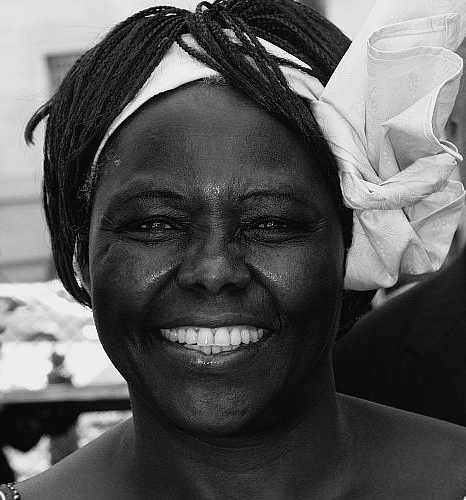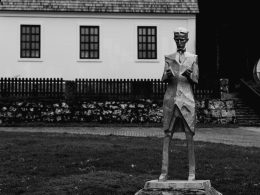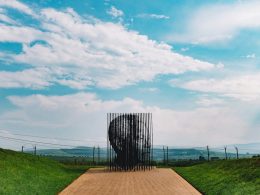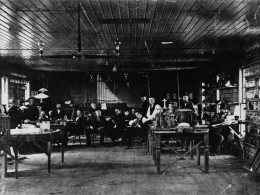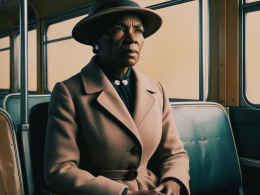Table of Contents Show
I. Roots of Resilience: Early Life in Rural Kenya
Wangari Maathai was born on April 1, 1940, in the small village of Ihithe, located in the central highlands of Kenya. Her early years were spent in a world defined by the rhythms of rural life, where the Kikuyu people, to whom she belonged, held a deep reverence for the land. The landscape of lush forests, fertile soil, and abundant water sources was not just a backdrop to her childhood but the foundation of her worldview—a view that placed the environment at the center of life.
Wangari’s parents were farmers, and like many in her community, they depended on the land for their livelihood. From a young age, Wangari was immersed in the traditional Kikuyu practices of farming, which were in harmony with the natural environment. She learned the importance of sustainable practices, understanding that the health of the land was directly tied to the well-being of the people. These early experiences instilled in her a profound respect for nature, a respect that would later underpin her life’s work.
However, Wangari’s early life was also shaped by the broader forces of colonialism. Kenya, then a British colony, was undergoing rapid changes as European settlers encroached on indigenous lands, displacing communities and disrupting traditional ways of life. The colonial government’s emphasis on cash crops like coffee and tea led to the destruction of forests and the depletion of the land’s fertility, changes that Wangari witnessed firsthand.
Despite the challenges, Wangari’s family placed a high value on education, a rarity in a time when girls were often denied formal schooling. She attended a local primary school before winning a scholarship to a prestigious Catholic high school. There, she excelled in her studies, particularly in the sciences, a subject that would become her passion. Her academic success opened doors that few African girls at the time could imagine, setting her on a path that would take her far from the rural village of her birth.
II. A Scholar in a New World: Education and Enlightenment Abroad
In 1960, Wangari Maathai received a scholarship to study in the United States as part of the “Kennedy Airlift,” a program designed to bring young Africans to American universities to prepare them for leadership roles in their newly independent nations. It was a transformative experience. Wangari enrolled at Mount St. Scholastica College in Kansas, where she pursued a degree in biological sciences, a field that spoke to her deep interest in the natural world.
America in the 1960s was a nation in turmoil, grappling with issues of civil rights, social justice, and environmental degradation. These movements left a lasting impression on Wangari, who was struck by the parallels between the struggles of African Americans and those of her own people under colonial rule. The burgeoning environmental movement, particularly the works of Rachel Carson, who exposed the dangers of pesticides in her book Silent Spring, resonated with Wangari’s growing awareness of the interconnectedness of all living things.
After completing her bachelor’s degree, Wangari continued her studies at the University of Pittsburgh, where she earned a Master’s degree in Biological Sciences. Her time in America broadened her intellectual horizons, exposing her to new ideas about democracy, human rights, and the role of science in society. It was also during this time that she began to see the connections between environmental conservation and social justice—a theme that would become central to her later work.
In 1966, Wangari returned to Kenya, armed with a wealth of knowledge and a determination to make a difference. She joined the University of Nairobi as a research assistant, and soon after, she became the first woman in East Africa to earn a Ph.D., specializing in veterinary anatomy. Her academic achievements were groundbreaking, but they also placed her in a male-dominated field where she often faced discrimination and resistance. Yet, Wangari was undeterred, using her position to advocate for the inclusion of women in the sciences and higher education.
III. Planting the Seeds of Change: The Birth of the Green Belt Movement
The idea that would define Wangari Maathai’s legacy came to her in the late 1970s, a period of growing political repression and environmental degradation in Kenya. The country’s rapid deforestation, driven by commercial logging and agricultural expansion, had devastated the land, leading to soil erosion, water scarcity, and the loss of biodiversity. The impact on rural communities, particularly women, was severe. They were forced to walk longer distances to find firewood and clean water, their livelihoods increasingly at risk.
Wangari recognized that the root of these problems lay in the destruction of the environment, and she conceived a simple yet powerful solution: plant trees. In 1977, she founded the Green Belt Movement, an organization that aimed to address the environmental crisis by mobilizing women to plant trees in their communities. The act of planting trees was symbolic, a way of restoring the land and reclaiming the rights of women who had been marginalized by both society and the government.
The Green Belt Movement was not just about reforestation; it was a grassroots initiative that empowered women by providing them with the tools and knowledge to improve their own lives. Women were trained to plant and care for trees, but they were also encouraged to speak out against the injustices they faced. Wangari’s vision was holistic—she saw environmental conservation as inseparable from issues of social justice, democracy, and human rights.
The movement quickly gained momentum, spreading across Kenya and beyond. By the 1980s, tens of thousands of women were involved, planting millions of trees and revitalizing degraded landscapes. The Green Belt Movement became a model for sustainable development, demonstrating that local communities could take control of their environment and their future. But as the movement grew, so did the challenges Wangari faced, particularly from the Kenyan government, which viewed her activism as a threat to its authority.
IV. Standing Tall: Confrontation and Struggle with the State
As the Green Belt Movement expanded, Wangari Maathai’s work increasingly brought her into conflict with the Kenyan government, led by President Daniel arap Moi. The regime was characterized by corruption, repression, and a disregard for human rights, and Wangari’s outspoken criticism of its policies made her a target. She became a thorn in the side of the government, particularly as she began to link environmental degradation with the broader issues of political oppression and economic inequality.
In the late 1980s and early 1990s, Wangari’s activism took on a more overtly political dimension. She became involved in the pro-democracy movement, calling for an end to Moi’s one-party rule and advocating for the rights of marginalized communities. Her activities made her a symbol of resistance, but they also placed her in great danger. She was harassed, arrested, and beaten by the authorities on several occasions, yet she refused to be silenced.
One of the most dramatic confrontations came in 1989 when Wangari led a campaign to prevent the construction of a skyscraper in Nairobi’s Uhuru Park, one of the few remaining green spaces in the city. The government planned to build a massive complex that would have destroyed the park, a project that Wangari saw as both environmentally destructive and emblematic of the regime’s disregard for the public good. Her protest drew international attention, and despite intense pressure, the project was eventually abandoned.
Wangari’s struggle against the Moi regime reached a climax in 1999 when she led a group of women in a hunger strike to demand the release of political prisoners. The protest took place in Karura Forest, another site threatened by government-backed deforestation. The government’s response was brutal—police attacked the protesters with batons, injuring many, including Wangari. Yet, the violence only strengthened her resolve, and the protest became a turning point in the fight for democracy in Kenya.
V. A Legacy of Hope: Global Recognition and the Nobel Peace Prize
Wangari Maathai’s unwavering commitment to environmental conservation and social justice did not go unnoticed. Over the years, she received numerous awards and honors, but the pinnacle of her recognition came in 2004 when she was awarded the Nobel Peace Prize. She was the first African woman to receive the prize, and the Nobel Committee acknowledged her “contribution to sustainable development, democracy, and peace.”
The Nobel Prize brought Wangari international acclaim, but she remained focused on the work that had always defined her life. She continued to lead the Green Belt Movement, which had by then planted over 30 million trees across Africa. She also became a global advocate for environmental conservation, women’s rights, and good governance, speaking at international forums and advising governments and organizations on sustainable development.
Wangari’s legacy is not just the millions of trees that now stand as living monuments to her vision, but the movement she inspired—a movement that empowered women, challenged oppressive regimes, and showed the world that the environment and human rights are inextricably linked. She demonstrated that real change begins at the grassroots, with ordinary people taking action in their own communities.
Wangari Maathai passed away on September 25, 2011, but her influence endures. The Green Belt Movement continues its work, and her ideas have inspired countless others to fight for environmental justice. She left behind a world that is greener, more just, and more aware of the connections between the health of our planet and the well-being of its people.
Wangari Maathai’s life was a testament to the power of resilience, courage, and vision. She stood tall against the forces that sought to silence her, and in doing so, she planted the seeds of a movement that will continue to grow for generations to come. Her story is one of hope and determination, a reminder that even in the face of overwhelming odds, one person can make a difference.




